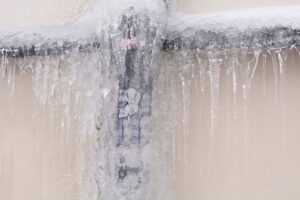What to Do to Prevent Frozen Pipes

*Updated on October 15th, 2025
When temperatures drop below freezing, your home’s plumbing system can be at serious risk. A frozen pipe is one of the most common winter problems homeowners face—and if left unchecked, it can lead to a burst pipe, major water damage, and costly repairs. When water inside a pipe freezes, it expands, creating pressure that can cause the pipe to crack or rupture.
The result? Expensive cleanup, loss of water service, and a whole lot of stress. The good news is that you can prevent frozen pipes with a few simple precautions. By preparing your plumbing before freezing temperatures hit, you can keep pipes from freezing and bursting and enjoy a worry-free winter.
Why Pipes Freeze
A pipe freezes when the water inside it reaches 32°F (0°C). This typically happens when pipes are located in unheated spaces, near exterior walls, or exposed to cold air drafts. Both metal and plastic water pipes are vulnerable since frozen water expands inside, straining the pipe walls.
The places where pipes are most likely to freeze include:
-
Outdoor hose bibs, sprinkler systems, and pool supply lines
-
Water supply lines in unheated areas like basements, crawl spaces, attics, and garages
-
Pipes running along an exterior wall with little insulation
When pipes have frozen, they block the flow of water and increase pressure throughout your water supply system. Once the frozen section begins to thaw, it can leak or burst, flooding your home.
How to Prevent Frozen Pipes
The most effective way to prevent frozen pipes is to stop them from reaching freezing temperatures in the first place. Here are key steps to help prevent pipes from freezing and bursting:
-
Drain the pipes supplying pools, sprinklers, and outdoor hose bibs before winter. Avoid using antifreeze unless specifically instructed, as it can harm pets, wildlife, and plants.
-
Disconnect and wrap pipes or garden hoses connected outdoors. Close the inside valves that feed outdoor faucets, then open the exterior ones to allow any remaining water to drain.
-
Add insulation to attics, basements, and crawl spaces to keep these areas warmer and reduce the risk of freezing.
-
Insulate pipes in unheated areas—like under kitchen or bathroom cabinets—using pipe sleeves, heat tape, or foam insulation. Follow safety guidelines and keep these materials away from flammable materials.
-
Protect your pipes by sealing air leaks near vents, windows, and doors to prevent cold air from reaching them.
-
Consider relocating exposed pipes in your home to warmer interior spaces if freezing problems persist. Consult a licensed plumber before major rerouting.
How to Keep Pipes from Freezing During Extreme Cold
Even with precautions, extreme weather can still put your plumbing at risk. During cold snaps, follow these tips to keep the water flowing and prevent your pipes from freezing:
-
Keep garage doors closed if water service lines run through the garage.
-
Open kitchen and bathroom cabinet doors to let warm air circulate around faucets and pipes. Move harmful cleaning products out of reach of children.
-
Let the cold water drip from any faucet served by exposed pipes. Running water through the pipe, even slowly, helps prevent freezing and pressure buildup.
-
Keep the thermostat set to the same temperature day and night—set to a temperature no lower than 55°F if you’re home or away.
-
If you’ll be away during cold weather, leave the heat on in your home and consider turning off the main water valve, then drain the pipes to prevent freezing while you’re gone.
These small adjustments can significantly reduce the chance that your pipes could freeze or burst.
How to Thaw Frozen Pipes Safely
If you suspect that pipes are frozen, act quickly. Here’s how to thaw frozen pipes before they burst:
-
Locate the frozen area by checking for faucets with little or no flow. The frozen line is usually near an exterior wall, crawl space, or basement.
-
Turn on the faucet connected to the frozen water pipe. This releases built-up pressure and lets melted water flow out.
-
Apply heat to the frozen section using a hair dryer, electric heating pad, space heater, or towels soaked in hot water. Move the heat evenly around the pipe until full water pressure is restored.
-
Never use an open flame like a blowtorch or propane heater, as these can damage the pipe or start a fire. Keep any heating device away from flammable materials.
-
If you’re unable to locate the frozen area, or if a broken pipe has already occurred, call a licensed plumber immediately.
If the frozen area is not accessible, or the pipes on your property have burst, it’s best to shut off your main water supply until professional help arrives.
What to Do If a Pipe Bursts
A burst pipe can flood your home within minutes. Take these steps to limit the damage:
-
Turn off the main water supply immediately to stop the flow.
-
If water is near outlets, turn off electrical power in that area to avoid hazards.
-
Mop up standing water right away using towels or a wet/dry vacuum.
-
Contact a professional plumber for emergency repair and inspection of your water service and frozen service lines.
Quick action can reduce long-term damage and help restore your water supply safely.
Recognizing Signs of Freezing Before Damage Occurs
Early detection helps avoid frozen pipes. Watch for:
-
Faucet and only a trickle of water coming out
-
Frost or condensation on exposed pipes
-
Odd noises like gurgling or banging when turning on a faucet
These are warnings that pipes may freeze soon. Apply heat to the frozen section or let a cold water drip from the faucet to prevent pressure buildup.
Conclusion
Frozen water pipes are more than just an inconvenience—they’re a serious risk to your home. But by taking proactive steps to prevent frozen pipes, insulate exposed areas, and keep your heat on, you can drastically lower the risk of a burst pipe this winter.
If your pipes are frozen, thaw the pipe carefully using safe heating methods, and call a licensed plumber if needed. Staying vigilant and following these tips will help prevent pipes from freezing and bursting, keeping your plumbing in top shape through the coldest months.
Additional Plumbing Resources
- Plumbing Repair Cost Guide
- How to Save Money on Plumbing Bills
- Does a Home Warranty Cover Plumbing Issues?

Anna has over six years of experience in the home services and journalism industries and serves as the Content Manager at MyHomePros.com, specializing in making complex home improvement topics like HVAC, roofing, and plumbing accessible to all. With a bachelor’s degree in journalism from Auburn University, she excels in crafting localized, comprehensive guides that cater to homeowners’ unique needs. Living on both coasts of the United States has equipped her with a distinctive perspective, fueling her passion for turning any house into a cherished home through informed, personalized decision-making.
Connect with top-rated local contractors who can help you with siding, roofing, HVAC, windows, and more. Get free quotes from verified professionals in your area today.








